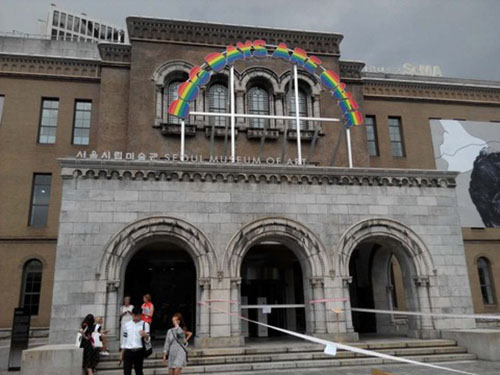Lee Bul’s Majestic Splendor, a room of bead-adorned decaying fish in bags, serves as a comment on the social
The National Museum of Modern and Contemporary Art is holding a 30th anniversary show, As the Moon Waxes and Wanes (until 12 February 2017), at its Gwacheon headquarters. Three-quarters of the 560 works are from MMCA’s collection, with the centrepiece being Nam June Paik’s tower of 1,003 television monitors, The More The Better. One section explores a history of Korean performance from the 1970s to the present, while other galleries are dedicated to well-known works from the collection and the institution’s history.
The museum’s Seoul location meanwhile hosts the installation Archive of Mind (until 5 February 2017), by the artist Kimsooja, who has wrapped the glass walls of the museum’s courtyard, surrounding her statue Deductive Object, with iridescent film. The museum is also showing the finalists for the Korea Artist Prize 2016 (until 15 January 2017): Mixrice, Ham Kyungah, Kim Eull and Back Seung Woo. The artist collective Mixrice have shifted from documenting emigration to Korea to exploring the movement and desolation of the country’s fauna, focusing particularly on one 1,000 year old tree. Ham continues her compelling work on North Korea by collaborating with a defector turned professional youth footballer, who used his ball to splash paint around a room. Supplementary pieces include lines carved on his old cleats to tell the story of his journey from the North. The prize winner is due to be announced in October.
Ham Kyungah collaborates with a North Korea defector turned professional youth footballer, who uses his ball to splash
paint around a room
Anish Kapoor has a solo show at Seoul’s Kukje Gallery, Gathering Clouds (until 30October), named after a new series of concave fibreglass disks coated in ominous dark grey pigment. The show also includes twisted mirrored sculptures in large and small. It is one of four exhibitions the artist has in the region this month: he is also due to participate in the Yinchuan Biennale and has a solo show at SCAI The Bathhouse in Tokyo from 9 September and his first solo show in Hong Kong at Gagosian Gallery, opening 12 September.
Anish Kapoor, Gathering Clouds at Seoul’s Kukje Gallery





